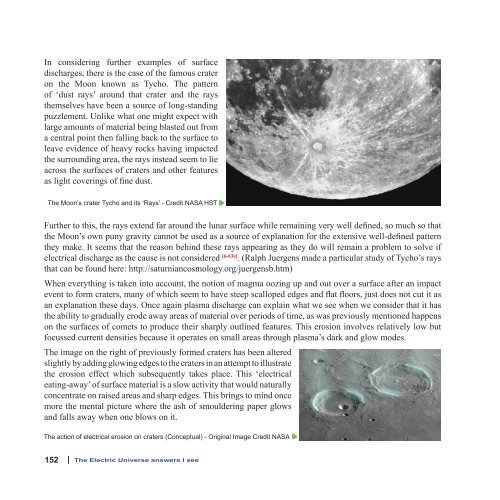A Beginner's View of Our Electric Universe - New
A Beginner's View of Our Electric Universe - New
A Beginner's View of Our Electric Universe - New
Create successful ePaper yourself
Turn your PDF publications into a flip-book with our unique Google optimized e-Paper software.
In considering further examples <strong>of</strong> surface<br />
discharges, there is the case <strong>of</strong> the famous crater<br />
on the Moon known as Tycho. The pattern<br />
<strong>of</strong> ‘dust rays’ around that crater and the rays<br />
themselves have been a source <strong>of</strong> long-standing<br />
puzzlement. Unlike what one might expect with<br />
large amounts <strong>of</strong> material being blasted out from<br />
a central point then falling back to the surface to<br />
leave evidence <strong>of</strong> heavy rocks having impacted<br />
the surrounding area, the rays instead seem to lie<br />
across the surfaces <strong>of</strong> craters and other features<br />
as light coverings <strong>of</strong> fine dust.<br />
The Moon’s crater Tycho and its ‘Rays’ - Credit NASA HST<br />
Further to this, the rays extend far around the lunar surface while remaining very well defined, so much so that<br />
the Moon’s own puny gravity cannot be used as a source <strong>of</strong> explanation for the extensive well-defined pattern<br />
they make. It seems that the reason behind these rays appearing as they do will remain a problem to solve if<br />
electrical discharge as the cause is not considered [6-63b] . (Ralph Juergens made a particular study <strong>of</strong> Tycho’s rays<br />
that can be found here: http://saturniancosmology.org/juergensb.htm)<br />
When everything is taken into account, the notion <strong>of</strong> magma oozing up and out over a surface after an impact<br />
event to form craters, many <strong>of</strong> which seem to have steep scalloped edges and flat floors, just does not cut it as<br />
an explanation these days. Once again plasma discharge can explain what we see when we consider that it has<br />
the ability to gradually erode away areas <strong>of</strong> material over periods <strong>of</strong> time, as was previously mentioned happens<br />
on the surfaces <strong>of</strong> comets to produce their sharply outlined features. This erosion involves relatively low but<br />
focussed current densities because it operates on small areas through plasma’s dark and glow modes.<br />
The image on the right <strong>of</strong> previously formed craters has been altered<br />
slightly by adding glowing edges to the craters in an attempt to illustrate<br />
the erosion effect which subsequently takes place. This ‘electrical<br />
eating-away’ <strong>of</strong> surface material is a slow activity that would naturally<br />
concentrate on raised areas and sharp edges. This brings to mind once<br />
more the mental picture where the ash <strong>of</strong> smouldering paper glows<br />
and falls away when one blows on it.<br />
The action <strong>of</strong> electrical erosion on craters (Conceptual) - Original Image Credit NASA<br />
152 | The <strong>Electric</strong> <strong>Universe</strong> answers I see


